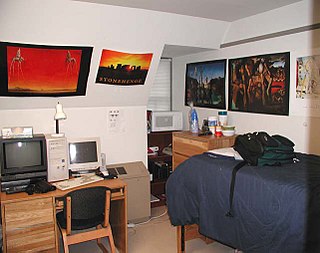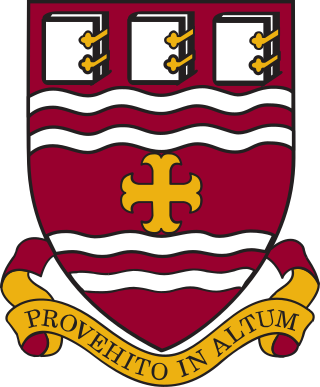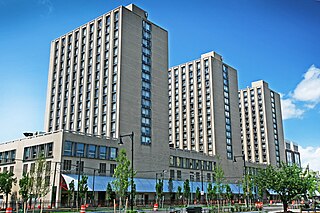
A dormitory is a building primarily providing sleeping and residential quarters for large numbers of people such as boarding school, high school, college or university students. In some countries, it can also refer to a room containing several beds accommodating people.

Memorial University of Newfoundland, also known as Memorial University or MUN, is a public research university in the province of Newfoundland and Labrador, based in St. John's, with satellite campuses in Corner Brook, elsewhere in Newfoundland and in Labrador, Saint Pierre, and Harlow, England. Memorial University offers certificate, diploma, undergraduate, graduate, and post-graduate programs, as well as online courses and degrees.
A resident assistant (RA), also known by a variety of other names, is a trained peer leader who coordinates activities in residence halls in colleges and universities, mental health and substance abuse residential facilities, or similar establishments.
A residential college is a division of a university that places academic activity in a community setting of students and faculty, usually at a residence and with shared meals, the college having a degree of autonomy and a federated relationship with the overall university. The term residential college is also used to describe a variety of other patterns, ranging from a dormitory with some academic programming, to continuing education programs for adults lasting a few days. In some parts of the world it simply refers to any organized on-campus housing, an example being University of Malaya.

Missouri Southern State University is a public university in Joplin, Missouri. It was established in 1937 as Joplin Junior College. The university enrolled 4,346 students in Fall 2021.
A Residence Hall Director is college or university employee generally responsible for the management and daily operations of campus residence halls. While the term Residence Hall Director is the common title used for this position in the United States, they are also known at different schools as Area Coordinators (ACs), Area Directors (ADs), Hall Coordinators (HCs), Community Directors (CDs), Hall Directors (HDs), Resident or Residence Directors (RDs), Resident Deans (RDs), Residence Hall Coordinators (RHCs), or Residence Life Coordinators (RLCs). While different titles are used by different colleges and universities, the positions generally have similar job requirements, dependent upon the size of the institution and scope of the position's overarching department.

With 12,500 residents, New York University has the 7th largest university housing system in the United States, the largest among private schools.

Amos Jerome Snell Hall and Charles Hitchcock Hall, more commonly known as Snell–Hitchcock, make up a residence hall at the University of Chicago. The dorm is on the northwest corner of the University's main quadrangles at the corner of 57th St. and Ellis Avenue. It is connected via emergency exits to Searle Chemistry Laboratory. Built in 1892 (Snell) and 1901 (Hitchcock), they are the oldest residence halls still in use as such on the university's campus. Snell is built in a Collegiate Gothic style, while Hitchcock is Prairie Style-inspired Gothic. The buildings feature fireplaces and exteriors of limestone, as well as hardwood molding and trim.

The Boston University housing system is the 2nd-largest of any private university in the United States, with 76% of the undergraduate population living on campus. On-campus housing at BU is an unusually diverse melange, ranging from individual 19th-century brownstone town houses and apartment buildings acquired by the school to large-scale high-rises built in the 60s and 2000s.

West Campus is a residential section of Cornell University's Ithaca, New York campus located west of Libe Slope and between the Fall Creek gorge and the Cascadilla gorge. It now primarily houses transfer students, second year students, and upperclassmen.

North Campus is a residential section of Cornell University's Ithaca, New York, campus located north of Fall Creek. It primarily houses freshmen. North Campus offers programs which ease the transition into college life for incoming freshmen. The campus offers interactions with faculty and other programs designed to increase interaction among members of the freshman class. North Campus is part of Cornell's residential initiative.
Student housing at the University of California, Irvine is separated between freshmen, continuing students, graduate students, and faculty. These accommodations serve a traditional purpose of housing residents, but also serve as a long-term outreach incentive for new freshmen and faculty. Student housing also play a key role in developing campuswide social activities.

Housing at the Massachusetts Institute of Technology (MIT) consists of eleven undergraduate dormitories and nine graduate dorms. All undergraduate students are required to live in an MIT residence during their first year of study. Undergraduate dorms are usually divided into suites or floors, and usually have Graduate Resident Assistants (GRA), graduate students living among the undergraduates who help support student morale and social activities. Many MIT undergraduate dorms are known for their distinctive student cultures and traditions.
Washington University in St. Louis has varied programs and events for students.
Summit Pacific College is an undergraduate and postgraduate Bible college and seminary, on a foothill of Sumas Mountain in Abbotsford, British Columbia, Canada. It is affiliated with Trinity Western University in Langley, BC. It is accredited by the Association for Biblical Higher Education and is the theological college of the BC & Yukon District of the Pentecostal Assemblies of Canada.

Rice University contains eleven residential colleges which function as the primary housing, dining, and social organizations for undergraduate students. The system was established in 1957 and was inspired by the residential college systems at the University of Oxford and the University of Cambridge as well as the American adaptations of the same at Harvard and Yale. Each student is randomly affiliated with a residential college upon matriculation and becomes a lifetime member of the college. The residential college system takes the place of a Greek system and has contributed to a sense of community that other universities have sought to emulate.
The McCormick Road Dormitories are one of two main areas of first-year living dormitories at the University of Virginia, the other being the Alderman Road Dormitories. Ten houses make up the residence area located on McCormick Road. The dormitory area was constructed in 1950 and holds nearly 1300 students. Although older and lacking in modern amenities compared to "New Dorms," Old Dorms are closer to Central Grounds and contain larger rooms.

Housing at the University of Chicago includes seven residence halls that are divided into 48 houses. Each house has an average of 70 students. Freshmen and sophomores must live on-campus. Limited on-campus housing is available to juniors and seniors. The university operates 28 apartment buildings near campus for graduate students.
Since the founding, Stanford University has provided on-campus housing for students. Today, all undergraduate students, most graduate students, and many graduate employees use campus housing. While not all graduate students are eligible for campus or subsidized off-campus housing, of those that are, only 64% are able to take advantage of this opportunity due to the limited housing stock. Student Housing at Stanford is currently part of Residential & Dining Enterprises, an in-house standalone vendor within the Stanford affiliated network of businesses.











